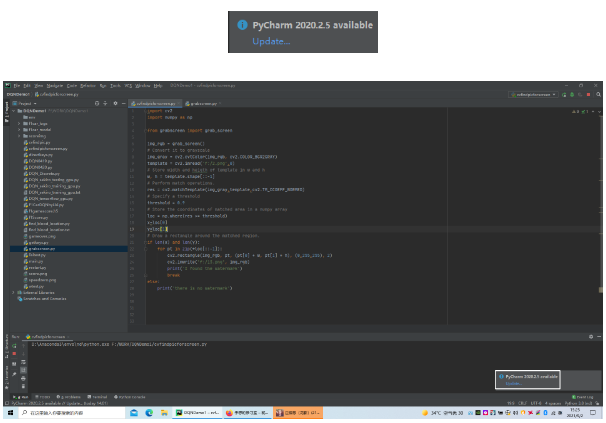grabscreen.py
---------------------------------
# -*- coding: utf-8 -*-
import cv2
import numpy as np
import win32gui, win32ui, win32con, win32api
def grab_screen(region=None):
hwin = win32gui.GetDesktopWindow()
if region:
left,top,x2,y2 = region
width = x2 - left + 1
height = y2 - top + 1
else:
width = win32api.GetSystemMetrics(win32con.SM_CXVIRTUALSCREEN)
height = win32api.GetSystemMetrics(win32con.SM_CYVIRTUALSCREEN)
left = win32api.GetSystemMetrics(win32con.SM_XVIRTUALSCREEN)
top = win32api.GetSystemMetrics(win32con.SM_YVIRTUALSCREEN)
hwindc = win32gui.GetWindowDC(hwin)
srcdc = win32ui.CreateDCFromHandle(hwindc)
memdc = srcdc.CreateCompatibleDC()
bmp = win32ui.CreateBitmap()
bmp.CreateCompatibleBitmap(srcdc, width, height)
memdc.SelectObject(bmp)
memdc.BitBlt((0, 0), (width, height), srcdc, (left, top), win32con.SRCCOPY)
signedIntsArray = bmp.GetBitmapBits(True)
img = np.fromstring(signedIntsArray, dtype='uint8')
img.shape = (height,width,4)
srcdc.DeleteDC()
memdc.DeleteDC()
win32gui.ReleaseDC(hwin, hwindc)
win32gui.DeleteObject(bmp.GetHandle())
return img
---------------------------------------------------
import cv2
import numpy as np
from grabscreen import grab_screen
# 这里是获取PC端屏幕
img_rgb = grab_screen()
# Convert it to grayscale
img_gray = cv2.cvtColor(img_rgb, cv2.COLOR_BGR2GRAY)
# 这里的2.png是我要查找的目标
template = cv2.imread('f:/2.png',0)
# Store width and heigth of template in w and h
w, h = template.shape[::-1]
# Perform match operations.
res = cv2.matchTemplate(img_gray,template,cv2.TM_CCOEFF_NORMED)
# Specify a threshold
# 这里0.9是匹配度
threshold = 0.9
# Store the coordinates of matched area in a numpy array
loc = np.where(res >= threshold)
x=loc[0]
y=loc[1]
# Draw a rectangle around the matched region.
if len(x) and len(y):
for pt in zip(*loc[::-1]):
# 这里画矩形框并输出图片,也可以改为自动化的点击等操作
cv2.rectangle(img_rgb, pt, (pt[0] + w, pt[1] + h), (0,255,255), 2)
cv2.imwrite("f:/13.png", img_rgb)
print('I found the watermark')
break
else:
print('there is no watermark')
效果图:

